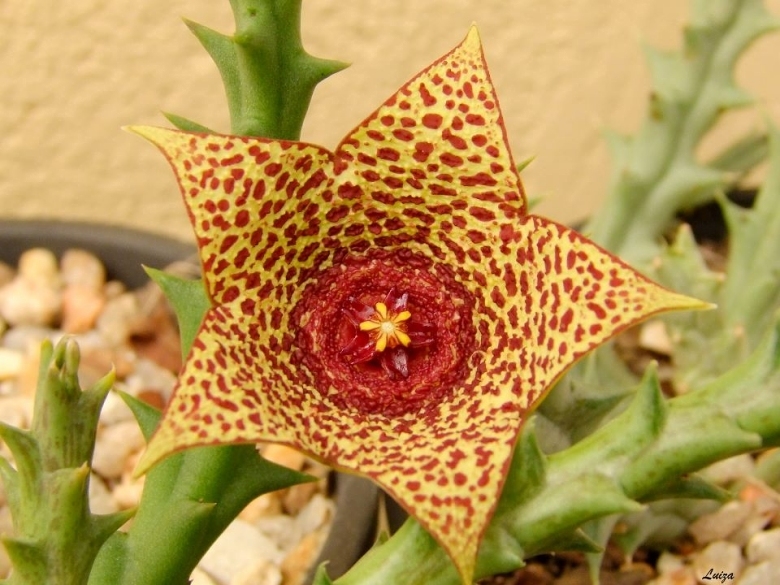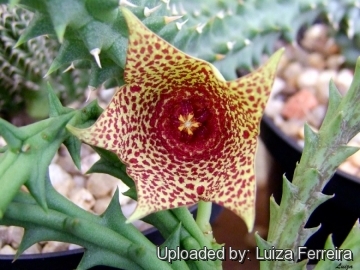Accepted Scientific Name: Orbea verrucosa (Masson) L.C.Leach
Kirkia 10(1): 290 1975.

Stisseria verrucosa (Orbea verrucosa) Photo by: Luiza Ferreira
Origin and Habitat: Eastern Cape, South Africa.
Altitude range: 20 - 1700 metres above sea level.
Habitat and Ecology: Orbea verrucosaSN|30532]]SN|30532]] grows in dry places in thickets and under shrubs.
Synonyms:
See all synonyms of Orbea verrucosa
back
Accepted name in llifle Database:Orbea verrucosa (Masson) L.C.LeachKirkia 10(1): 290 1975.Synonymy: 11
Accepted name in llifle Database:Orbea verrucosa var. fucosa (N.E.Br.) L.C.LeachExcelsa Taxon. Ser. 1: 25 1978Synonymy: 2
back
Common Names include:
ENGLISH: Warty-Flowered Stapelia, Carrion flower
AFRIKAANS (Afrikaans): Aasblom
Description: Orbea verrucosaSN|30532]]SN|30532]] is a succulent, leafless perennial with strongly toothed stems up to 80 mm long, erect forming small clumps or mats. The five pointed, cupped, star-shaped flowers are finely warted or irregularly ridged and have a 'life-belt' ring (or annolus) around the centre, they are pale yellow with dark purple marks, but varies considerably in the depth of the yellow ground-colour and the darkness of the spotting. Two subspecies are recognized, the nominate form and var. fucosa (Stapelia fucosaSN|30537]]SN|30537]]).
Stems: Erect, decumbent at the base, 3.5-8 cm long, 6-16 mm across excluding spreading teeth, obtusely 4-angled, with spreading conical acute teeth 3-8 mm long, glabrous, green.
Flowers: 1–3 together near the base of the young stems, developing successively. Peduncles longer than corolla 12-30 mm long, spreading, glabrous. Sepals 5-10 mm long, lanceolate or ovate-lanceolate, acuminate, glabrous. Corolla in bud conically pointed, with a depressed-ovate pentagonal basal part, when expanded 4-6.5 mm across, subcampanulate five cleft halfway, with the united part saucer or shallowly basin-shaped, 4-6 mm deep outside, having a distinct slightly raised pentagonal solid annulus surrounding the corona, about 1 mm high, convex at the top, with 5 distinct channels radiating from the centre to its angles. Lobes recurved-spreading, 16-20 mm long, 12-16 mm broad, deltoid-ovate, very acute or acuminate, not ciliate; all parts glabrous or with some short erect hairs at the very base under and concealed by the corona, smooth outside; inside very rugose, finely warted or irregularly ridged, pale yellow with pale purple-brown to almost black spots, smaller and more crowded on the annulus, with the area around the corona entirely dark purple or purple-brown. Outer corona-lobes horizontally or slightly deflexed-spreading, about 1.5-2 mm long and broad, subquadrate, acutely bifid, with a minute tooth at the base of the broadly rounded notch, dark chocolate, with yellowish margins. Inner corona-lobes about 1.5-2 mm long from the shoulder, subhorizontally incumbent upon the backs of the anthers and slightly longer than them, but not or scarcely erect at the tips, ovate-lanceolate, acuminate, slightly gibbous on the back at the base, yellow, with the gibbosity and the margins purple-brown, without extended horns or wing.
Fruits: The fruit are paired spindle-shaped capsules (follicles), resembling the horns of an antelope, with the tightly packed seeds inside. At maturity they split open to release numerous small brown seeds crowned with long white hairs.
Subspecies, varieties, forms and cultivars of plants belonging to the Orbea verrucosa group
 Orbea verrucosa (Masson) L.C.Leach: has strongly toothed stems up to 80 mm, erect, decumbent at the base. Distribution: from Uniondale eastwards to the Kei River.
Orbea verrucosa (Masson) L.C.Leach: has strongly toothed stems up to 80 mm, erect, decumbent at the base. Distribution: from Uniondale eastwards to the Kei River.- Orbea verrucosa var. fucosa (N.E.Br.) L.C.Leach: has weakly-toothed stems and smaller, more heavily spotted flowers. Distribution: occupies the eastern distribution, from Queenstown to Umtata and Mount Ayliff.
Bibliography: Major references and further lectures
1) N. E. Brown “Flora Capensis”, Vol 4, 1909
2) Victor, J.E. 2005. “Orbea verrucosa (Masson) L.C.Leach.” National Assessment: Red List of South African Plants version 2014.1. Accessed on 2015/02/17
3) Court, “Succulent flora of southern Africa”, A.A. Balkema, Rotterdam 1981
4) James Cullen, Sabina G. Knees, H. Suzanne Cubey “The European Garden Flora Flowering Plants: A Manual for the Identification of Plants Cultivated in Europe, Both Out-of-Doors and Under Glass” Cambridge University Press, 11 August 2011
5) Botanical Magazine, 786 (1809)
6) Flowering Plants of South Africa, 12: 480 (1932) & 18: 706 (1938)
7) White & Sloane, "The Stapelieae", edn 2, 2:1. 371-80 (1937)
8) Excelsa Taxonomic Series 1: 22-4 (1978).
9) George Don “A General System of Gardening and Botany” Rivington, 1838
 Stisseria verrucosa (Orbea verrucosa) Photo by: Luiza Ferreira
Stisseria verrucosa (Orbea verrucosa) Photo by: Luiza Ferreira Stisseria verrucosa (Orbea verrucosa) Photo by: Frikkie Hall
Stisseria verrucosa (Orbea verrucosa) Photo by: Frikkie Hall Stisseria verrucosa (Orbea verrucosa) Photo by: Luiza Ferreira
Stisseria verrucosa (Orbea verrucosa) Photo by: Luiza FerreiraSend a photo of this plant.The gallery now contains thousands of pictures, however it is possible to do even more. We are, of course, seeking photos of species not yet shown in the gallery but not only that, we are also looking for better pictures than those already present.
Read More... Cultivation and Propagation: Orbea verrucosaSN|30532]]SN|30532]] grow well in light gritty soil with a very liberal drainage. They should at all times sparingly watered (best rain water with some occasional fertiliser), and in winter time they hardly require any. They require outdoor culture, or a warm close greenhouse, while growing in the early part of summer, and afterwards may be ripened and kept in a greenhouse; but as they bloom chiefly in autumn, warmth is desirable to enable them to expand their flowers.
A minimum winter temperature of 5-10°C is acceptable, providing that plants are kept absolutely dry. They prefer light shade rather than full sun, although stems may not colour up under shady conditions.
Propagation: Plants are usually increased by cuttings, which, as they are very succulent, should be allowed to dry a week after they are taken off, when they may at once be put singly into pots.
Pest & diseases: Keep their roots free of mealy bugs, as fungal attack often occurs as a result of damage to stems by insects. A layer of grit on the surface of the compost prevents moisture from accumulating around the base of the stems and minimise the chance of fungal attack on the roots.
Traditional uses: This species is sporadically collected for food by local people.














